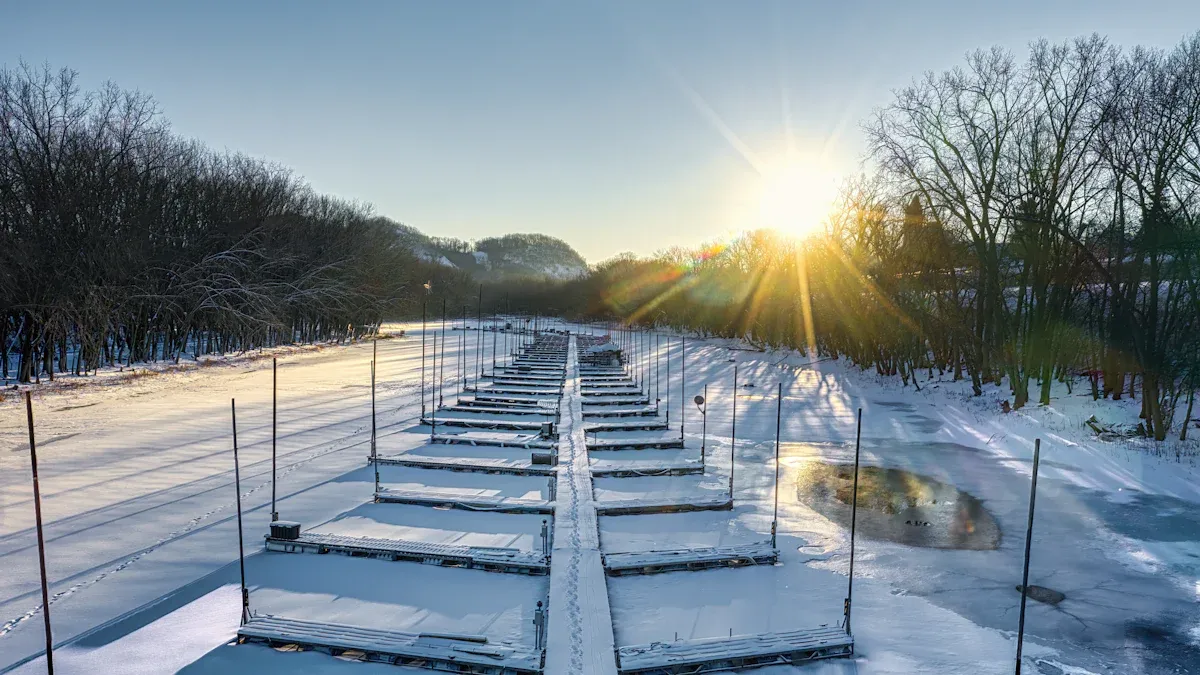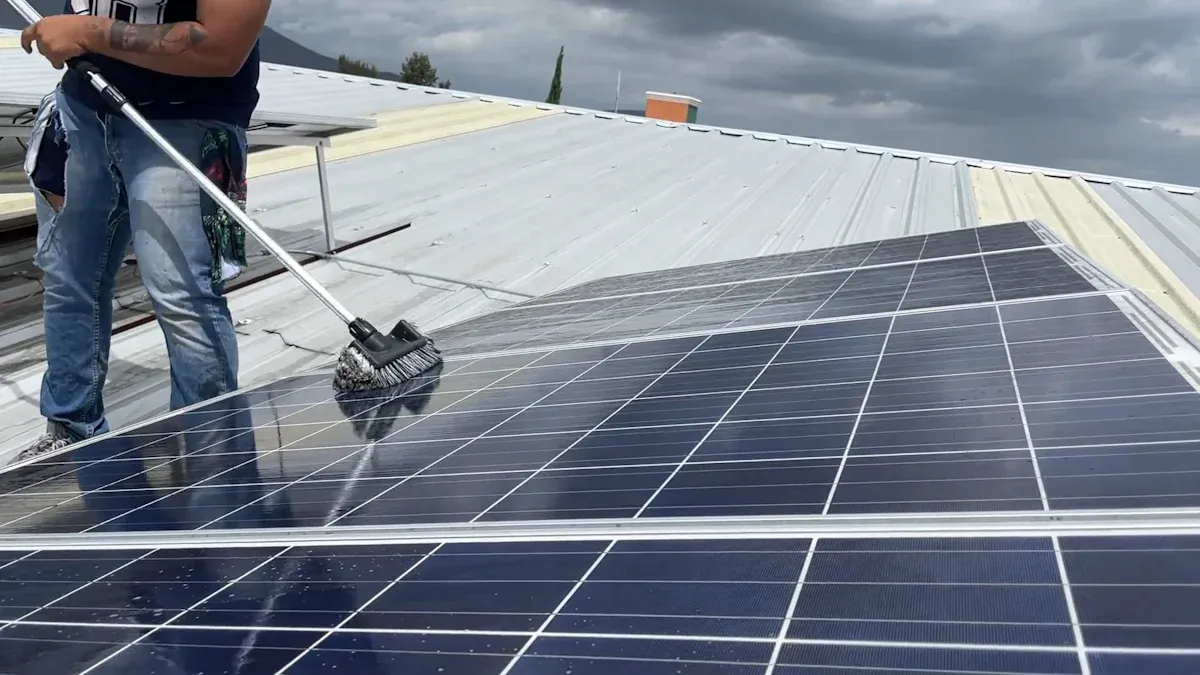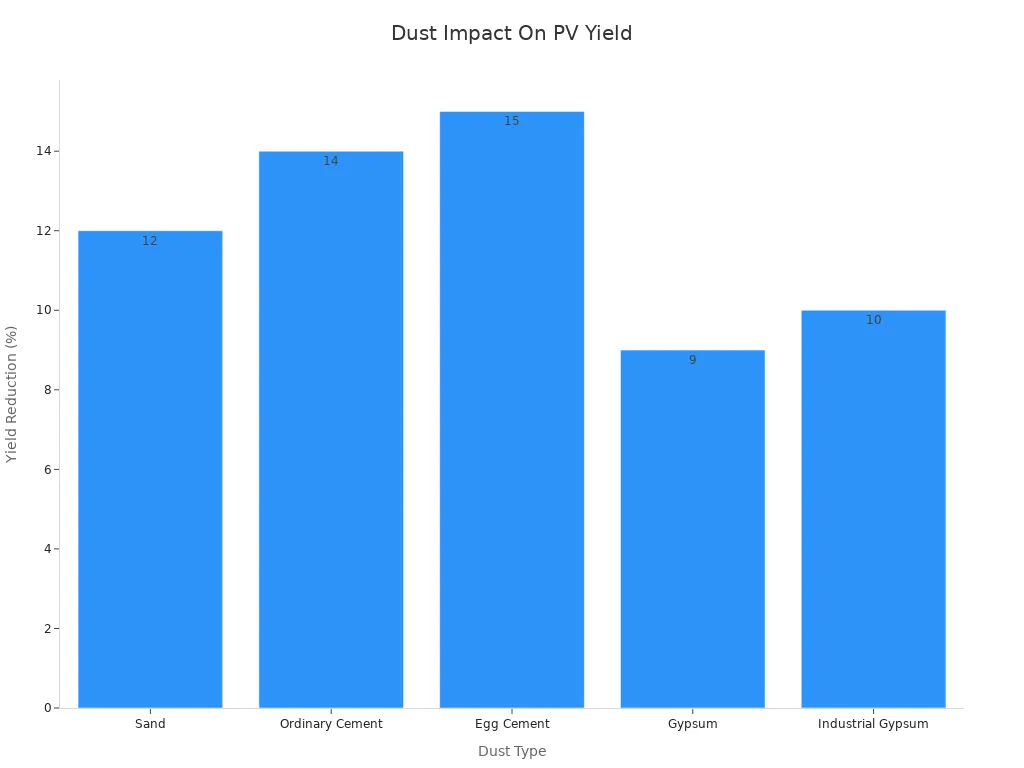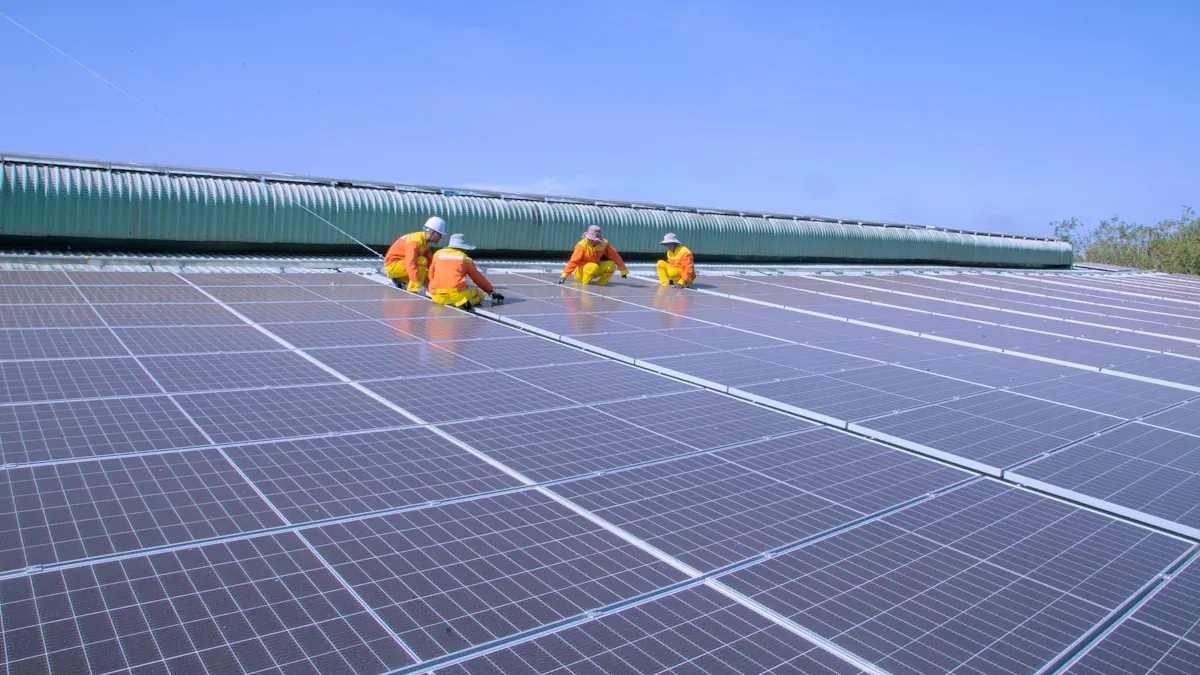
Weather plays a big role in how often you need to clean solar panels. You might see efficiency losses from 4% to 25% because of dirt or dust.
- Wind, rain, and humidity all change how quickly dust settles.
Cleaning schedules often change with the seasons and local conditions.
Key Takeaways
- Weather like rain, dust storms, pollen, snow, and coastal salt affects how often you need to clean solar panels to keep them working well.
- Look for visible dirt, streaks, or drops in energy output as signs that your panels need cleaning after weather events.
- Follow cleaning schedules based on your local climate, such as more frequent cleaning in dusty or coastal areas, to maintain panel efficiency.
How Weather Impacts Solar Panel Cleaning Frequency

Rain and Its Limits for Solar Panels
Rain can help clean your solar panels, but it does not always remove all the dirt. Light rain often leaves behind dust and small particles. In some places, you need at least 20 mm (about 0.8 inches) of rainfall for rain to clean panels well. If rainfall is less than 0.3 mm, it does not clean the panels at all. Sometimes, after a rain, you may still see a thin layer of dirt or streaks. Rain works better on larger dust particles, but smaller ones can stick to the surface.
| Rainfall Amount | Cleaning Effectiveness |
|---|---|
| < 0.3 mm | No cleaning |
| 0.5 mm | Some cleaning, not complete |
| 5 mm | Often not enough for full cleaning |
| 20 mm | Effective cleaning, restores output |
| Large dust particles | Rain cleans well |
| Small dust particles | Rain less effective |
You should not rely only on rain to keep your solar panels clean, especially if you live in a dry or dusty area.
Dust and Sand Storms Affecting Solar Panels
Dust and sand storms can quickly cover your solar panels with a thick layer of dirt. This layer blocks sunlight and lowers the amount of electricity your panels make. Studies show that dust can reduce power output by up to 20% in just 45 days. In some desert regions, a 5% drop in power happens when only about 2 grams of dust cover each square meter. After a sandstorm, you may need to clean your panels every three weeks to keep them working well.
- Dust builds up faster if your panels are flat or close together.
- Tilted panels collect less dust.
- Wind can blow dust onto panels, but strong winds can also help remove some dirt.
Tip: If you live in a dusty area, check your panels often after storms. Cleaning schedules should change based on how much dust you see.
Pollen Season and Solar Panels
Pollen can stick to your solar panels, especially in spring and early summer. When trees, grasses, and weeds release pollen, it settles on surfaces and forms a yellow or green layer. Pollen seasons have become longer in many places, sometimes by up to 27 days. This means your panels may need extra cleaning during these months.
- Spring brings the most pollen from trees like birch and oak.
- Summer adds pollen from grasses and weeds.
- Pollen can mix with rain and form sticky spots on your panels.
If you see a yellow film or notice a drop in energy output, it may be time to clean your panels.
Snow and Ice on Solar Panels
Snow and ice can cover your solar panels and block sunlight. When snow piles up, your panels stop making electricity until the snow melts or you remove it. Light, powdery snow may slide off on its own, but heavy, wet snow can stick and even form ice layers. Ice lets some sunlight through, but it still lowers efficiency.
Panels work better in cold weather because low temperatures help electricity flow. Most panels are tilted, so snow slides off more easily. When snow slides off, it can also take dirt and dust with it, giving your panels a natural cleaning.
Note: In snowy areas, you may need to clear your panels after big storms. Use a soft broom or hire a professional to avoid damage.
Coastal Salt, Humidity, and Solar Panels
If you live near the ocean, salt and humidity can affect your solar panels. Salt from sea spray sticks to the surface and can cause corrosion over time. High humidity makes dust and salt stick even more. In some coastal areas, performance losses can reach up to 60-70% if you do not clean your panels often.
- Coastal regions often have high humidity, especially in summer.
- Fine sand and salt mix with moisture and form thick layers on panels.
- Regular cleaning helps prevent damage and keeps your panels working well.
Coastal tip: Clean your panels more often if you see a white or sticky film on the surface.
Wildfire Smoke, Ash, and Solar Panels
Wildfires create smoke and ash that can travel far and settle on your solar panels. Ash forms a gray or black layer that blocks sunlight. Smoke particles are very small and can stick tightly to the surface, making them hard to remove with just rain.
- After a wildfire, you may see a sharp drop in your panel’s energy output.
- Ash and soot can mix with dew or rain and form a sticky residue.
- Cleaning is important after wildfire events to restore your panel’s performance.
If you live in an area with frequent wildfires, check your panels after each event and clean them as needed.
Signs Your Solar Panels Need Cleaning After Weather
Visible Dirt or Debris on Solar Panels
You can often spot when your solar panels need cleaning just by looking at them. If you see dust, leaves, or bird droppings, it is time to take action. Studies show that visible dirt can cause energy losses from 2.8% up to 50%, depending on how much dust builds up. This drop in performance happens in many places around the world. When you notice dirt or debris, you know your panels are not working as well as they could. New technology can even spot dust levels with almost perfect accuracy, making it easier to decide when to clean.
Streaks or Residue After Rain on Solar Panels
Rain does not always wash away all the grime. Sometimes, you might see streaks or a sticky film left behind. This residue can come from pollen, bird droppings, or pollution. In one case, a sticky brown haze caused a 10% drop in energy output. After cleaning, the panels worked even better than before. If you see streaks or haze after rain, your panels likely need a good cleaning to restore their power.
Drop in Solar Panel Energy Output
A sudden or steady drop in your solar panel’s energy output is a clear sign that cleaning is needed. When dust and dirt build up, they block sunlight and lower the amount of electricity your system makes. Models show that pollution and dust can cut energy production by up to 15% or more, depending on the type and amount of dirt. If you track your energy output and see it falling, check your panels for dirt.
| Dust Type | PV Yield Reduction (%) |
|---|---|
| Carbon Dust | Not specified |
| Natural Dust | 9-15 |
| Sand | 12 |
| Ordinary Cement | 14 |
| Egg Cement | 15 |
| Gypsum | 9 |
| Industrial Gypsum | 10 |

Unusual Glare or Cloudiness on Solar Panels
If you notice a strange glare or your panels look cloudy, this can mean a layer of dust or residue is blocking the surface. Clean panels should look clear and shiny. Cloudiness or glare often means dirt is scattering the sunlight, which lowers efficiency. You should check your panels often, especially after storms or pollen season, to keep them working their best.
Recommended Solar Panel Cleaning Schedules by Climate

Arid and Dusty Regions
You need to clean your solar panels more often in dry, dusty places. Dust builds up quickly and blocks sunlight. Studies in Morocco show that cleaning every three weeks works best to keep energy losses low. If you use special coatings, you can cut water use in half and keep your panels cleaner for longer. Try to check your panels after dust storms or during dry months. Using soiling sensors helps you know when to clean.
Tip: Panels with a tilt shed dust better than flat ones.
Coastal Areas
Salt and humidity near the ocean can stick to your panels and cause damage. In places with high salt, you may need to clean your panels every year or even more often. Standard cleaning schedules do not always work well in these areas. You should look for signs of salt buildup, like a white film, and adjust your cleaning plan as needed.
| Zone Type | Suggested Cleaning Interval |
|---|---|
| High salt, humid | Every year |
| Medium pollution | Every 4-6 years |
Urban and Industrial Zones
Cities have more air pollution and fine dust. These particles stick to solar panels and lower their output. In Delhi, pollution can cut energy by 12% each year. Rain does not always wash away fine dust, so you should check your panels often. Cleaning every two to three months helps keep your system working well.
Rural and Agricultural Areas
Farms and rural areas bring pollen, dust, and plant debris. You may see more dirt during harvest or pollen season. Check your panels every month, especially in spring and fall. Cleaning after storms or heavy winds also helps.
Snowy Climates
Snow can cover your panels and stop them from making power. After a big snowfall, clear the panels safely. In winter, check your panels after each storm. Most snow slides off tilted panels, but you should still watch for ice or thick snow.
Weather shapes how often you clean your solar panels. You should check for dirt, debris, or lower energy output. Try these best practices:
- Inspect your panels for damage or dirt.
- Track your energy production for sudden drops.
- Schedule professional inspections each year.
Regular cleaning and monitoring help you keep your system efficient and avoid costly repairs.
FAQ
How often should you check your solar panels for dirt?
You should check your panels every month. Look for dust, leaves, or bird droppings. Regular checks help you spot problems early.
Can you use tap water to clean solar panels?
Yes, you can use tap water. Use a soft sponge or cloth. Avoid harsh chemicals. Clean gently to protect the panel surface.
What happens if you never clean your solar panels?
If you never clean your panels, dirt builds up. This lowers energy output. You may lose up to 25% of your panel’s efficiency.
Post time: Jul-14-2025
